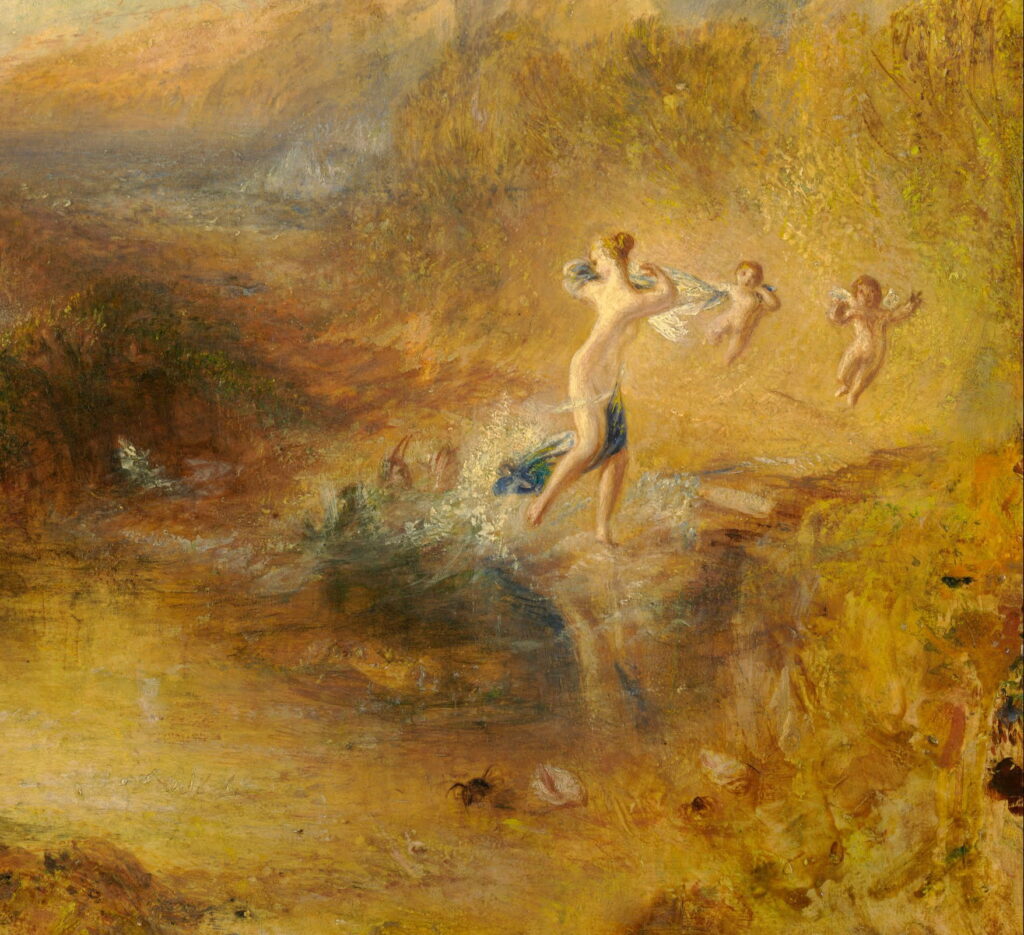Changing Paintings: 64 Scylla meets Glaucus

By the end of Book 13 of Ovid’s Metamorphoses, Aeneas is on the island of Sicily. Scylla has been combing Galatea’s hair, listening to her tell the tragic story of the death of her lover Acis. Ovid resumes the narration for the tale of Scylla, which doesn’t conclude until the start of the next book.
Scylla is walking naked along the beach when the figure of Glaucus suddenly breaks the surface of the water. He’s immediately enchanted by her, and tries to engage her in conversation to stop her from running away. But Scylla runs away in terror, and climbs a nearby cliff. There, she gets her breath back, and tries to work out whether he’s a god or monster with long hair and fishy scales below the waist.
Glaucus assures her that he’s a sea-god. He had once been an ordinary mortal, and fished with nets, and rod and line. One day, the fish that he had caught started to move when he had laid them out on the grass, and one by one they escaped back into the water. He couldn’t understand how that had happened, so chewed stems of the plants they had rested on. He was then transformed and swam off in the sea to visit the gods Tethys and Oceanus for removal of the last remains of his mortal form.
Scylla runs away, leaving Glaucus angry, so he makes his way to the sorceress Circe.
Bartholomeus Spranger (1546–1611), Glaucus and Scylla (1580-82), oil on canvas, 110 × 81 cm, Kunsthistorisches Museum, Vienna, Austria. Wikimedia Commons.
Bartholomeus Spranger painted his version of Glaucus and Scylla in 1580-82. Although the artist hasn’t followed Ovid’s distinctive colour scheme for his body, Glaucus is clearly pleading his case before the beautiful young woman. In the next book, Ovid will describe how Scylla was turned into a rock, and Spranger provides that link forward in the story in his background.
Salvator Rosa (1615-1673), Glaucus and Scylla (date not known), oil on canvas, 87.5 x 75 cm, Musée des Beaux-Arts de Caen, Caen, France. Wikimedia Commons.
In the middle of the seventeenth century, Salvator Rosa makes Glaucus more of a beast, roughly mauling Scylla’s fair body and giving her good cause for her flight to the cliff.
Nicola Vaccaro (1640–1709), Glaucus fleeing from Scylla (date not known), oil, dimensions and location not known. Wikimedia Commons.
A little later, probably in the late seventeenth century, Nicola Vaccaro is more sympathetic in his Glaucus fleeing from Scylla. Glaucus may be a bit rough, but arouses more pity. Scylla is accompanied by three Cupids as she flees not to the top of a cliff, but to the goddess Diana above.
The most interesting and unusual depiction of this story is surely JMW Turner’s from 1841, just a decade before his death.
Joseph Mallord William Turner (1775–1851), Glaucus and Scylla (1841), oil on panel, 78.3 x 77.5 cm, Kimbell Art Museum, Fort Worth, TX. Wikimedia Commons.
Turner’s Glaucus and Scylla (1841) would perhaps have looked more at home among paintings made fifty or even eighty years later.
The naked Scylla is on the beach at the right, with a couple of cupids flying about. The inchoate form of Glaucus is emerging to the left of centre, holding his arms out towards Scylla. She will have none of it, though, and has already turned to run, and looks back over her shoulder towards him.
We look directly into the setting sun colouring the world a rich gold. In the right background the low coastal land rises to sheer cliffs with a temple on top. A tower atop a nearer pinnacle, or more distant lower red rocks, may be a reference to Scylla’s fate.
Joseph Mallord William Turner (1775–1851), Glaucus and Scylla (detail) (1841), oil on panel, 78.3 x 77.5 cm, Kimbell Art Museum, Fort Worth, TX. Wikimedia Commons.
In the foreground are clues of the beach setting, with a crab, and several seashells. Turner has applied his paint in innovative and gestural ways, resulting in richly varied textures.
Turner had made an earlier and more traditional study in about 1810-15, but revised it almost completely by the time that he painted this in 1841. Its light appears influenced by the harbour landscapes of Claude, and its general lack of form anticipates Impressionism, perhaps even Abstract Expressionism in passages.
Rejected by the scared Scylla, Glaucus travels from Sicily to visit the sorceress Circe, whom he implores to use her dark arts to force Scylla to return his love. But Circe refuses, telling Glaucus to woo another: as she is in love with him, he could spurn Scylla and love Circe instead.
Glaucus rejects her, saying that nothing will change his love for Scylla. That annoys Circe, who cannot harm Glaucus because of her love for him, so turns her anger on Scylla instead. The sorceress prepares a magical potion from herbs, weaving her spells into it. Dressed in a deep blue robe, she then goes to a small bay where Scylla likes to bathe, and pours her potion into the water.
When Scylla wades into the water the lower half of her body is transformed into a pack of dogs. As Ulysses’ ship passes her, those dogs take some of its crew, but they allow Aeneas to pass safely. Scylla is finally transformed into a rock and becomes a famous hazard to navigation.
John William Waterhouse (1849-1917), Circe Invidiosa (1892), oil on canvas, 180.7 x 87.4 cm, Art Gallery of South Australia, Adelaide, Australia. Wikimedia Commons.
John William Waterhouse chose to portray the figure of Circe the sorceress in his Circe Invidiosa (1892). Despite its narrative limitations, this offers a marvellous insight into the character of Circe, as she pours her brilliant emerald green potion into the water, ready for Scylla to come and bathe.
John Melhuish Strudwick (1849–1937), Circë and Scylla (1886), oil on canvas, dimensions not known, Sudley House, Liverpool, England. Wikimedia Commons.
John Melhuish Strudwick also chooses a moment early in Ovid’s story, which makes his painting of Circë and Scylla (1886) narratively rather thin. Circe, dressed in brown rather than blue, is sprinkling her potion into the water from within a small cave, as Scylla, at the left, walks down to bathe.
Eglon Hendrik van der Neer (1634–1703), Circe Punishes Glaucus by Turning Scylla into a Monster (1695), oil on canvas, 64 x 53.3 cm, Rijksmuseum Amsterdam, Amsterdam, The Netherlands. Wikimedia Commons.
By far the most complete visual account is Eglon van der Neer’s Circe Punishes Glaucus by Turning Scylla into a Monster (1695). Circe takes the limelight, as she casts her potion from a flaming silver salver held in her right hand. Dripping onto that is the wax from a large candle, held in her left hand. In the water below, Scylla has already been transformed into a gorgonesque figure, with snakes for hair, and the grotesque Glaucus watches from behind. Above and to the right of Circe is a small dragon perched on a rock ledge.
Ary Renan (1857–1900), Charybdis and Scylla (1894), oil on canvas, 89.5 x 130 cm, Musée de la Vie romantique, Paris. Wikimedia Commons.
Ary Renan’s Charybdis and Scylla (1894) shows Charybdis the whirlpool with its mountainous standing waves at the left, and the rocks of Scylla at the right.
Alessandro Allori (1535–1607), (Odysseus passing Scylla and Charybdis) (c 1575), fresco, dimensions and location not known. Wikimedia Commons.
This fragment of fresco by Alessandro Allori shows Odysseus’ ship passing Charybdis, depicted as a huge head vomiting forth the rough waters of the whirlpool at the right, and the dogs’ heads of Scylla, which have captured three of Odysseus’ crew.
Henry Fuseli (1741–1825), Odysseus in front of Scylla and Charybdis (1794-96), oil on canvas, 126 × 101 cm, Aargauer Kunsthaus, Aarau, Switzerland. Wikimedia Commons.
Henry Fuseli’s Odysseus in front of Scylla and Charybdis (1794-96) is another vivid depiction of Odysseus passing the twin dangers. He stands on the fo’c’s’le of his ship, holding his shield up in defence as the oarsmen down below him struggle to propel the craft through the Straits of Messina.




